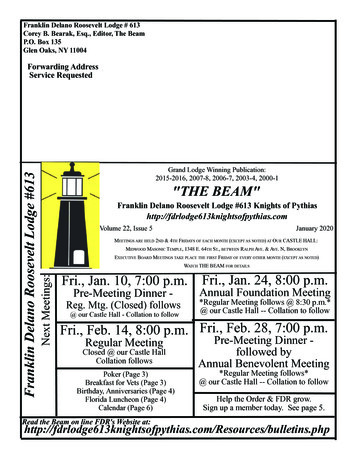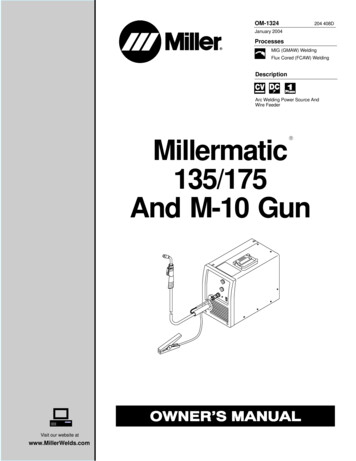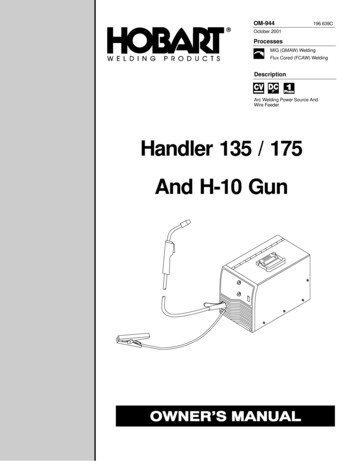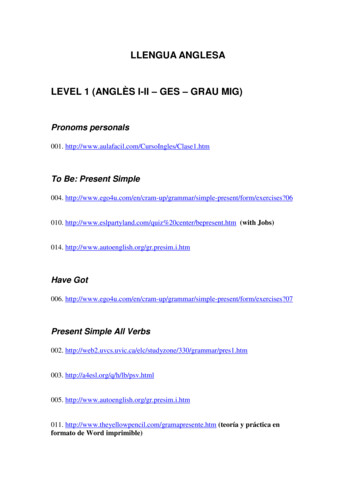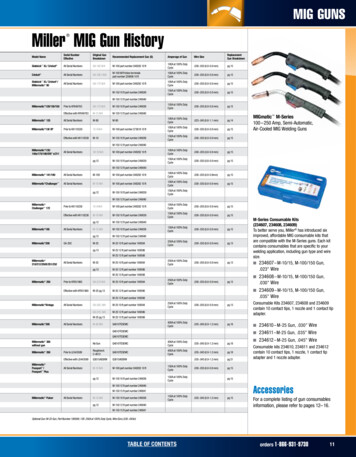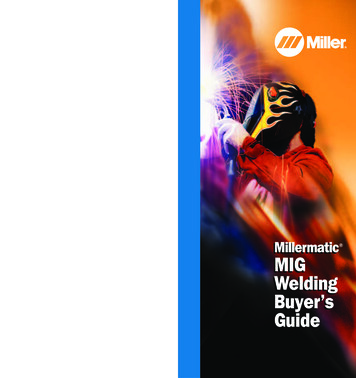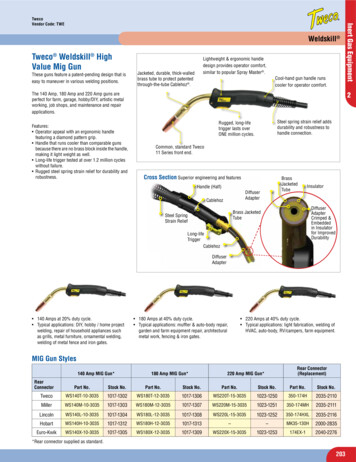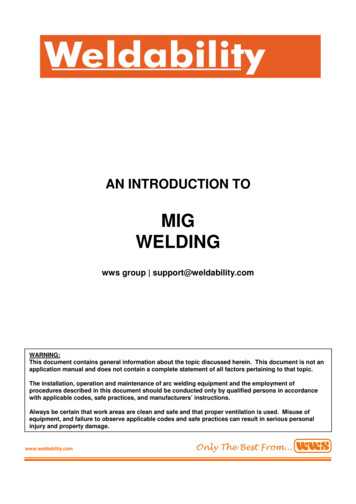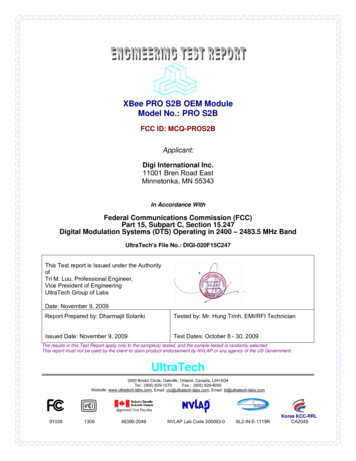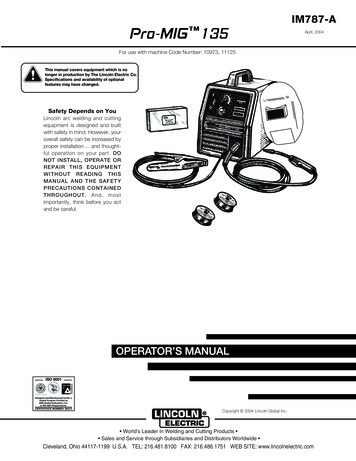
Transcription
IM787-APro-MIG 135April, 2004For use with machine Code Number: 10973, 11125This manual covers equipment which is nolonger in production by The Lincoln Electric Co.Specifications and availability of optionalfeatures may have changed.Safety Depends on YouLincoln arc welding and cuttingequipment is designed and builtwith safety in mind. However, youroverall safety can be increased byproper installation . and thoughtful operation on your part. DONOT INSTALL, OPERATE ORREPAIR THIS EQUIPMENTWITHOUT READING THISMANUAL AND THE SAFETYPRECAUTIONS CONTAINEDTHROUGHOUT. And, mostimportantly, think before you actand be careful.Pro-MIG 135OPERATOR’S MANUALISO 9001ANSI RABQMSDesigned and Manufactured Under aQuality Program Certified byABS Quality Evaluations, Inc.to ISO 9001 Requirements.CERTIFICATE NUMBER: 30273Copyright 2004 Lincoln Global Inc. World's Leader in Welding and Cutting Products Sales and Service through Subsidiaries and Distributors Worldwide Cleveland, Ohio 44117-1199 U.S.A. TEL: 216.481.8100 FAX: 216.486.1751 WEB SITE: www.lincolnelectric.com
iiSAFETYWARNINGCALIFORNIA PROPOSITION 65 WARNINGSThe engine exhaust from this product containsDiesel engine exhaust and some of its constituentschemicals known to the State of California to causeare known to the State of California to cause cancancer, birth defects, or other reproductive harm.cer, birth defects, and other reproductive harm.The Above For Gasoline EnginesThe Above For Diesel EnginesARC WELDING CAN BE HAZARDOUS. PROTECT YOURSELF AND OTHERS FROM POSSIBLE SERIOUS INJURY OR DEATH.KEEP CHILDREN AWAY. PACEMAKER WEARERS SHOULD CONSULT WITH THEIR DOCTOR BEFORE OPERATING.Read and understand the following safety highlights. For additional safety information, it is strongly recommended that youpurchase a copy of “Safety in Welding & Cutting - ANSI Standard Z49.1” from the American Welding Society, P.O. Box351040, Miami, Florida 33135 or CSA Standard W117.2-1974. A Free copy of “Arc Welding Safety” booklet E205 is availablefrom the Lincoln Electric Company, 22801 St. Clair Avenue, Cleveland, Ohio 44117-1199.BE SURE THAT ALL INSTALLATION, OPERATION, MAINTENANCE AND REPAIR PROCEDURES AREPERFORMED ONLY BY QUALIFIED INDIVIDUALS.FOR ENGINEpowered equipment.1.h. To avoid scalding, do not remove theradiator pressure cap when the engine ishot.1.a. Turn the engine off before troubleshooting and maintenancework unless the maintenance work requires it to be running.1.b.Operate engines in open, well-ventilatedareas or vent the engine exhaust fumesoutdoors.1.c. Do not add the fuel near an open flamewelding arc or when the engine is running.Stop the engine and allow it to cool beforerefueling to prevent spilled fuel from vaporizing on contact with hot engine parts andigniting. Do not spill fuel when filling tank. Iffuel is spilled, wipe it up and do not startengine until fumes have been eliminated.1.d. Keep all equipment safety guards, covers and devices inposition and in good repair.Keep hands, hair, clothing andtools away from V-belts, gears, fans and all other movingparts when starting, operating or repairing equipment.1.e. In some cases it may be necessary to remove safetyguards to perform required maintenance. Removeguards only when necessary and replace them when themaintenance requiring their removal is complete.Always use the greatest care when working near movingparts.1.f. Do not put your hands near the engine fan.Do not attempt to override the governor oridler by pushing on the throttle control rodswhile the engine is running.ELECTRIC ANDMAGNETIC FIELDSmay be dangerous2.a. Electric current flowing through any conductor causeslocalized Electric and Magnetic Fields (EMF). Weldingcurrent creates EMF fields around welding cables andwelding machines2.b. EMF fields may interfere with some pacemakers, andwelders having a pacemaker should consult their physicianbefore welding.2.c. Exposure to EMF fields in welding may have other healtheffects which are now not known.2.d. All welders should use the following procedures in order tominimize exposure to EMF fields from the welding circuit:2.d.1. Route the electrode and work cables together - Securethem with tape when possible.2.d.2. Never coil the electrode lead around your body.2.d.3. Do not place your body between the electrode andwork cables. If the electrode cable is on your rightside, the work cable should also be on your right side.2.d.4. Connect the work cable to the workpiece as close aspossible to the area being welded.1.g. To prevent accidentally starting gasoline engines whileturning the engine or welding generator during maintenancework, disconnect the spark plug wires, distributor cap ormagneto wire as appropriate.2.d.5. Do not work next to welding power source.Mar ‘95
iiiiSAFETYELECTRIC SHOCK cankill.3.a. The electrode and work (or ground) circuitsare electrically “hot” when the welder is on.Do not touch these “hot” parts with your bareskin or wet clothing. Wear dry, hole-freegloves to insulate hands.3.b. Insulate yourself from work and ground using dry insulation.Make certain the insulation is large enough to cover your fullarea of physical contact with work and ground.In addition to the normal safety precautions, if weldingmust be performed under electrically hazardousconditions (in damp locations or while wearing wetclothing; on metal structures such as floors, gratings orscaffolds; when in cramped positions such as sitting,kneeling or lying, if there is a high risk of unavoidable oraccidental contact with the workpiece or ground) usethe following equipment: Semiautomatic DC Constant Voltage (Wire) Welder. DC Manual (Stick) Welder. AC Welder with Reduced Voltage Control.3.c. In semiautomatic or automatic wire welding, the electrode,electrode reel, welding head, nozzle or semiautomaticwelding gun are also electrically “hot”.3.d. Always be sure the work cable makes a good electricalconnection with the metal being welded. The connectionshould be as close as possible to the area being welded.3.e. Ground the work or metal to be welded to a good electrical(earth) ground.3.f. Maintain the electrode holder, work clamp, welding cable andwelding machine in good, safe operating condition. Replacedamaged insulation.3.g. Never dip the electrode in water for cooling.3.h. Never simultaneously touch electrically “hot” parts ofelectrode holders connected to two welders because voltagebetween the two can be the total of the open circuit voltageof both welders.3.i. When working above floor level, use a safety belt to protectyourself from a fall should you get a shock.3.j. Also see Items 6.c. and 8.ARC RAYS can burn.4.a. Use a shield with the proper filter and coverplates to protect your eyes from sparks andthe rays of the arc when welding or observingopen arc welding. Headshield and filter lensshould conform to ANSI Z87. I standards.4.b. Use suitable clothing made from durable flame-resistantmaterial to protect your skin and that of your helpers fromthe arc rays.4.c. Protect other nearby personnel with suitable, non-flammablescreening and/or warn them not to watch the arc nor exposethemselves to the arc rays or to hot spatter or metal.FUMES AND GASEScan be dangerous.5.a. Welding may produce fumes and gaseshazardous to health. Avoid breathing thesefumes and gases.When welding, keepyour head out of the fume. Use enoughventilation and/or exhaust at the arc to keepfumes and gases away from the breathing zone. Whenwelding with electrodes which require specialventilation such as stainless or hard facing (seeinstructions on container or MSDS) or on lead orcadmium plated steel and other metals or coatingswhich produce highly toxic fumes, keep exposure aslow as possible and below Threshold Limit Values (TLV)using local exhaust or mechanical ventilation. Inconfined spaces or in some circumstances, outdoors, arespirator may be required. Additional precautions arealso required when welding on galvanized steel.5.b. Do not weld in locations near chlorinated hydrocarbon vaporscoming from degreasing, cleaning or spraying operations.The heat and rays of the arc can react with solvent vapors toform phosgene, a highly toxic gas, and other irritatingproducts.5.c. Shielding gases used for arc welding can displace air andcause injury or death. Always use enough ventilation,especially in confined areas, to insure breathing air is safe.5.d. Read and understand the manufacturer’s instructions for thisequipment and the consumables to be used, including thematerial safety data sheet (MSDS) and follow youremployer’s safety practices. MSDS forms are available fromyour welding distributor or from the manufacturer.5.e. Also see item 1.b.Mar ‘95
iiiiiiSAFETYWELDING SPARKS cancause fire or explosion.6.a. Remove fire hazards from the welding area.If this is not possible, cover them to preventthe welding sparks from starting a fire.Remember that welding sparks and hotmaterials from welding can easily go through small cracksand openings to adjacent areas. Avoid welding nearhydraulic lines. Have a fire extinguisher readily available.6.b. Where compressed gases are to be used at the job site,special precautions should be used to prevent hazardoussituations. Refer to “Safety in Welding and Cutting” (ANSIStandard Z49.1) and the operating information for theequipment being used.6.c. When not welding, make certain no part of the electrodecircuit is touching the work or ground. Accidental contactcan cause overheating and create a fire hazard.6.d. Do not heat, cut or weld tanks, drums or containers until theproper steps have been taken to insure that such procedureswill not cause flammable or toxic vapors from substancesinside. They can cause an explosion even though they havebeen “cleaned”. For information, purchase “RecommendedSafe Practices for the Preparation for Welding and Cutting ofContainers and Piping That Have Held HazardousSubstances”, AWS F4.1 from the American Welding Society(see address above).6.e. Vent hollow castings or containers before heating, cutting orwelding. They may explode.6.f. Sparks and spatter are thrown from the welding arc. Wear oilfree protective garments such as leather gloves, heavy shirt,cuffless trousers, high shoes and a cap over your hair. Wearear plugs when welding out of position or in confined places.Always wear safety glasses with side shields when in awelding area.6.g. Connect the work cable to the work as close to the weldingarea as practical. Work cables connected to the buildingframework or other locations away from the welding areaincrease the possibility of the welding current passingthrough lifting chains, crane cables or other alternate circuits. This can create fire hazards or overheat lifting chainsor cables until they fail.6.h. Also see item 1.c.CYLINDER may explodeif damaged.7.a. Use only compressed gas cylinderscontaining the correct shielding gas for theprocess used and properly operatingregulators designed for the gas andpressure used. All hoses, fittings, etc. should be suitable forthe application and maintained in good condition.7.b. Always keep cylinders in an upright position securelychained to an undercarriage or fixed support.7.c. Cylinders should be located: Away from areas where they may be struck or subjected tophysical damage. A safe distance from arc welding or cutting operations andany other source of heat, sparks, or flame.7.d. Never allow the electrode, electrode holder or any otherelectrically “hot” parts to touch a cylinder.7.e. Keep your head and face away from the cylinder valve outletwhen opening the cylinder valve.7.f. Valve protection caps should always be in place and handtight except when the cylinder is in use or connected foruse.7.g. Read and follow the instructions on compressed gascylinders, associated equipment, and CGA publication P-l,“Precautions for Safe Handling of Compressed Gases inCylinders,” available from the Compressed Gas Association1235 Jefferson Davis Highway, Arlington, VA 22202.FOR ELECTRICALLYpowered equipment.8.a. Turn off input power using the disconnectswitch at the fuse box before working onthe equipment.8.b. Install equipment in accordance with the U.S. NationalElectrical Code, all local codes and the manufacturer’srecommendations.8.c. Ground the equipment in accordance with the U.S. NationalElectrical Code and the manufacturer’s recommendations.Mar ‘95
ivivSAFETYPRÉCAUTIONS DE SÛRETÉPour votre propre protection lire et observer toutes les instructions et les précautions de sûreté specifiques qui parraissentdans ce manuel aussi bien que les précautions de sûretégénérales suivantes:Sûreté Pour Soudage A L’Arc1. Protegez-vous contre la secousse électrique:a. Les circuits à l’électrode et à la piéce sont sous tensionquand la machine à souder est en marche. Eviter toujourstout contact entre les parties sous tension et la peau nueou les vétements mouillés. Porter des gants secs et sanstrous pour isoler les mains.b. Faire trés attention de bien s’isoler de la masse quand onsoude dans des endroits humides, ou sur un planchermetallique ou des grilles metalliques, principalement dansles positions assis ou couché pour lesquelles unegrande partie du corps peut être en contact avec lamasse.c. Maintenir le porte-électrode, la pince de masse, le câblede soudage et la machine à souder en bon et sûr étatdefonctionnement.d.Ne jamais plonger le porte-électrode dans l’eau pour lerefroidir.e. Ne jamais toucher simultanément les parties sous tensiondes porte-électrodes connectés à deux machines à souder parce que la tension entre les deux pinces peut être letotal de la tension à vide des deux machines.f. Si on utilise la machine à souder comme une source decourant pour soudage semi-automatique, ces precautionspour le porte-électrode s’applicuent aussi au pistolet desoudage.2. Dans le cas de travail au dessus du niveau du sol, se protéger contre les chutes dans le cas ou on recoit un choc. Nejamais enrouler le câble-électrode autour de n’importe quellepartie du corps.3. Un coup d’a
Pro-MIG 135 Sales and Service through Subsidiaries and Distributors Worldwide † Cleveland, Ohio 44117-1199 U.S.A. TEL: 216.481.8100 FAX: 216.486.1751 WEB SITE: www.lincolnelectric.com † World's Leader in Welding and Cutting Products † ISO 9001 CERTIFICATE NUMBER: 30273 Designed and Manufactured Under a Quality Program Certified by ABS Quality Evaluations, Inc. to ISO 9001 .
